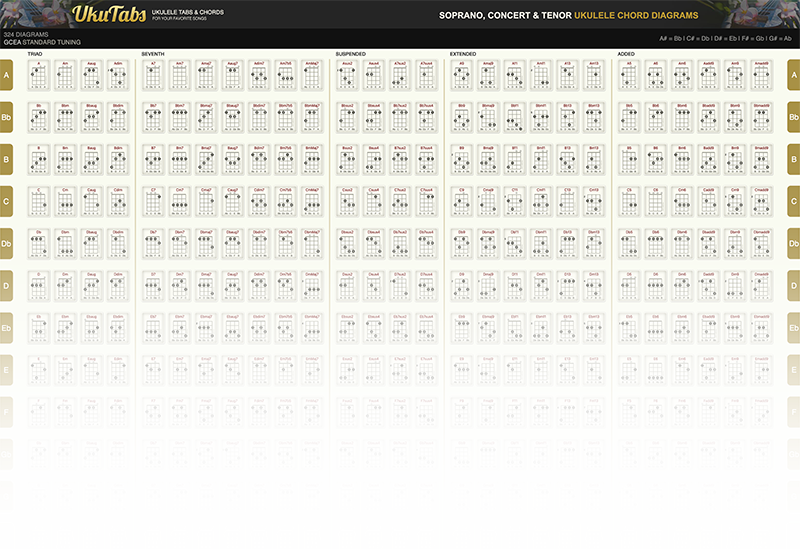When you are just starting out with playing the ukulele it can be quite overwhelming, especially if it’s your first instrument ever. In this guide you will find out everything about the ukulele basic chords for beginners.
Which are the ukulele basic chords for beginners?
Don’t panic, but there are dozens of chords and hundreds of ways to play them on a ukulele (see them all in the UkuTabs Chord Library).
You might run into problems with difficult chord diagrams, painful fingers, strumming, feeling the rhythm, tablatures, etc. Although the UkuTabs chord charts already show you the easiest way to play all the “main chords” (180 in total), you can slim things down quite a bit more. Read on! Having troubles reading chord diagrams? Check out how to read chord charts here.
1. Seven absolute basic ukulele chords
The first basic ukulele chords you should start learning are Am, C, F and G. Learning these four basic chords will allow you to play most popular songs in the C key by for example Bob Dylan, Adele, Tom Petty, Bruce Springsteen, Taylor Swift and Creedence Clearwater Revival.
Ready for some more? Add the three ukulele chords D major, E major and E minor to the mix and you’re set to play almost all songs in the G key.
While these seven ukulele chords already opens up a very wide range of songs that you can play, it’s only the tip of the metaphorical ukulele chords iceberg. Ready for the next step in learning ukulele chords? Let’s learn some major, minor and seventh chords to become a true ukulele guru.
2. Major Chords
Everything starts with the seven major chords: A B C D E F G (= La Ti Do Re Mi Fa Sol). The most important ones in this list are A C D E F and G. So basically, all of them except the B chord. The B isn’t used that much, which is a good thing because it isn’t that easy to play.
Another chord that isn’t easy to play is the E chord. Unfortunately, this one is used in quite a lot of songs. That’s why I’ve written a guide dedicated entirely to this E chord. Want help on how to play the horrific E chord?
3. Minor Chords
After the major chords, we have the minor chords. They are also among the basic ukulele chords for beginners. Minor chords are widely used, and they can give the song a more intimate feel, whereas major chords sound happier and more upbeat.
The ones that are most important to learn when you are just starting out are Am, Dm and Em. For your reference, I have listed all the minor chords below.
4. Seventh Chords
Some people may dispute this, but I personally think that 7th chords are also very important basic ukulele chords, and actually not that difficult to play either! They can add a groovy, funky feeling to the song and are used a lot in jazz, soul and uptown songs.
My favourite is the F7, but I would recommend learning all of them (except maybe the B7). They will also help you when improvising and changing things up to make a song sound more interesting.
Conclusion – Ukulele basis chords for beginners
In my opinion, these are the ukulele basic chords that every player should learn at the beginning. You can pick a few to start with and then expand. If you know all the chords listed on this page (or most of them), you will already be able to play a very wide range of songs. Keep in mind that you can always transpose a song to a different key to make it a little bit easier!
Want to learn more chords? Take a look at the UkuTabs Chord Library, which contains an archive of almost every ukulele chord out there. It allows you to select a chord and it will immediately show you how to play that chord on the ukulele. There are also free A2 posters and A4 PDFs available with all the chord diagrams.

Need more input?
I hope this guide has taught you a lot about the ukulele basic chords for beginners.
5 Frequently Asked Questions about Basic Chords
The easiest chords for beginners are C, F, and G7. These three chords use only one or two fingers and let you play lots of simple songs right away.
With just a few basic chords (like C, F, G, and Am) you can play hundreds of popular songs. Learning only a few more will expand your options even further. Go by it step by step.
Some chords, especially those using three or four fingers, can feel awkward at first. The E chord is a well known chord for this. With practice your fingers will get stronger and more flexible. The shapes will become much easier over time.
While the shapes look similar, they create different chords because of the different tuning. For example, a guitar D shape is a G chord on the ukulele.
Major chords sound bright and happy, while minor chords typically sound more sad or moody. On a chord chart, the difference is usually just one note, but it completely changes the feel of the song.
Feel free to contact me whenever you need more information. Keep practising and have fun!
Also interested in how to read ukulele chord diagrams?
